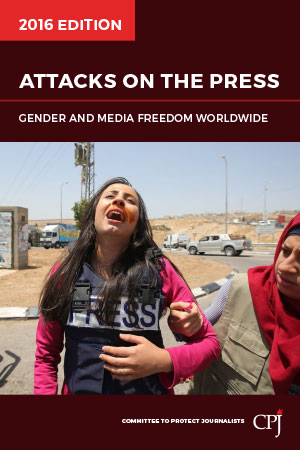I am a hugger. Maybe it’s my Texas heritage, but the value of wrapping people in a warm embrace at the right time has stayed with me, like a hint of twang, in the 40 years since I left the state. And hugs have been just the right thing many times during the decades that the safety of journalists has been a big part of my working life.
When journalists are headed to their first assignment in a tough place, no matter how much training they’ve had, no matter how many serious talks about preparation and assessing risk they’ve had, it just doesn’t seem right to send them off with a sober handshake. I need to put an arm or two around their shoulders.
People coming home get hugs of welcome and thanks, newbies and seasoned veterans alike. Maybe especially seasoned veterans, who carry so many horrible images and experiences that most of us can only know through their work. And I take hugs with me (calibrated for different cultures) when visiting Associated Press staff around the world, one of the great privileges of my life.

It’s clear that I can hug people because I am a woman. A red-haired, married, middle-aged working mother with a loud-ish laugh. Change one thing-gender-and imagine a loud-ish, red-haired middle-aged man in a suit opening his arms wide as he approaches.
Yeah. It doesn’t feel quite the same.
Is hugging a leadership tool? The very question makes human resources executives queasy. After all, physical contact in the workplace is usually more of a problem than a solution.
When we’re asking people to work in places where every decision they make must be weighed against the potential threat to their lives, we need all the tools we can muster.
That’s why, in the right circumstances, hugs are essential. Nurturing, too.
Now that’s a loaded word for leaders who are women because it’s one of the clichéd descriptions that most of us have heard at one time or another.
It’s part of the caricature that makes many women bristle.
You know; “She’s soft and nurturing.” The opposite of “She’s bossy and too tough.”
In my experience, though, you need every trait available on the soft-tough continuum when you are looking after people who work in difficult places. You need intuition and heart when listening to them. You need to be firm about assignments and safety protocols. You need to be organized enough to have plans ready in case something goes wrong. Then you need to be fast, relentless, tough and if, God forbid, something does go wrong, tender.
How does anyone-woman or man-learn how to do that?
Sadly, most of us learn it by brute experience, which is frustrating, terrifying, rewarding, occasionally exhilarating, and always very hard.
Good training and tools are increasingly available to journalists who work in dangerous places, even for those who are most imperiled … the ones covering the places where they live.
There is precious little training for bosses.
Some of us have good informal networks with colleagues, even competitors, who face the same challenges. Those informal networks, and the splendid folks at CPJ, are a resource when things go wrong.
Because the dangers are growing every year, we have to ask if that is enough.
Shouldn’t we do more to prepare newsroom leaders in charge of journalists in dodgy places?
In other professions, leadership training includes extensive time with case studies. There’s not much of that around safety issues in journalism, though. The hard-won wisdom lives with individuals and sometimes in pockets of news organizations.
A number of things get in the way of the kind of sharing that makes an effective case study. First, because lives are at stake, people can be reluctant to share details of how a sticky situation was resolved, even when the resolution is a good one.
There are legal risks-risks to the channels invoked while trying to get the journalist out of danger and other sensitive details that a company may choose not to share.
The employer isn’t the only person with a stake here. Family members almost always have a say, and sometimes they disagree among themselves. Once safe, the journalist may have a view.
As a result, lessons often are confined to the news organization that has been through the ordeal.
The reasons are understandable, but it means other leaders often do not benefit from the experiences of those who’ve been in those difficult positions before.
So for now, leaders often have to rely on the experience of their own organization when a journalist is wounded or killed. And they have to rely on intuition.
If you’ve walked that path, you know you must put aside your feelings and summon calm strength to take care of your stricken journalist, their family, and their peers in the organization.
You must help them work through fear, sorrow, and all the other raw feelings they will have. You must help them gather to gain strength from each other.
On those most dreadful days, your most effective leadership tools will be a nurturing compassion, strength and, at least for me, an endless supply of quiet hugs.
Kathleen Carroll, vice chair of CPJ’s board of directors, is executive editor and senior vice president of The Associated Press.
